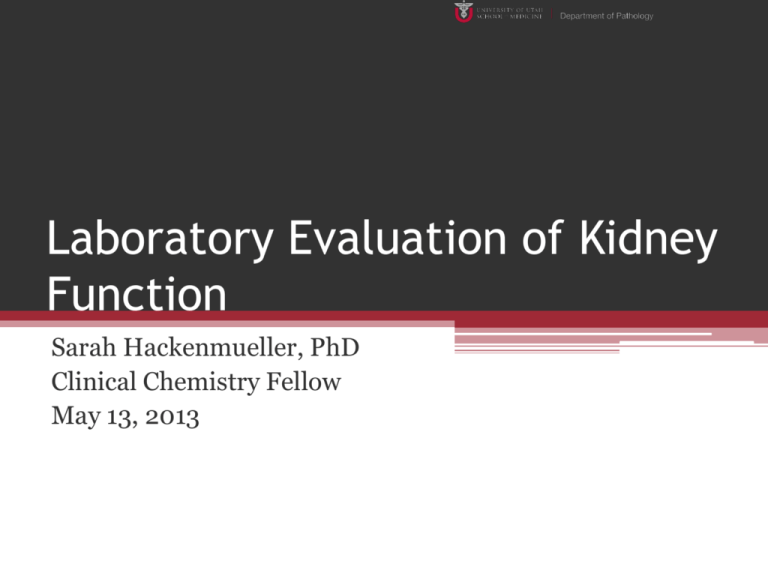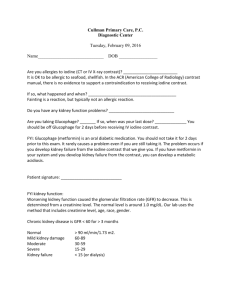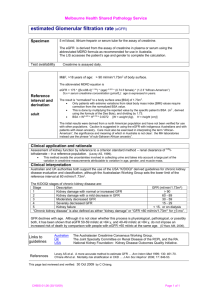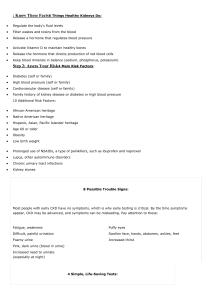Laboratory Evaluation of Kidney Function
advertisement

Laboratory Evaluation of Kidney Function Sarah Hackenmueller, PhD Clinical Chemistry Fellow May 13, 2013 University of Utah CME Statements • The University of Utah School of Medicine adheres to ACCME Standards regarding industry support of continuing medical education. • Speakers are also expected to openly disclose intent to discuss any off-label, experimental, or investigational use of drugs, devices, or equipment in their presentations. • This speaker has nothing to disclose. Objectives • At the end of this presentation, participants should be able to: ▫ Diagram the functional unit of the kidney. ▫ Compare and contrast the markers used to evaluate glomerular filtration rate. ▫ List criteria for staging chronic kidney disease. Outline • Review of the kidneys ▫ Anatomy ▫ Physiology ▫ Pathophysiology • Assessment of kidney function in chronic disease ▫ Laboratory tests ▫ Clinical practice guidelines Case Study My doctor just told me I have stage 2 kidney disease. My doctor just told me I have stage 3 kidney disease! Anatomy and Physiology Overview of Kidneys • Functions: ▫ Regulation of homeostasis Electrolytes Water Acid-base balance ▫ Remove waste and toxins from the body Filtration and excretion ▫ Synthesize hormones Anatomy • Size: ~12 cm long and ~150 g • Receive 25% of cardiac output ▫ Cardiac output ~3 L/min ▫ Kidneys ~0.75 L/min • Filters 180 L per day • Produces urine ▫ 0.4-2 L per day http://www.umm.edu/patiented/articles/what_kidney_stones_000081_1.htm Nephron • Functional unit of the kidney Proximal Convoluted tubule Distal tubule ▫ 0.6 – 1.5 million per kidney • Composed of: ▫ ▫ ▫ ▫ ▫ Glomerulus Proximal tubule Loop of Henle Distal tubule Collecting duct Collecting duct Loop of Henle http://www.unckidneycenter.org/kidneyhealthlibrary/glomerulardisease.html Glomerulus • Function: to filter plasma to form an ultrafiltrate • Size exclusion • Charge exclusion http://robbwolf.com/2011/06/16/clearing-up-kidney-confusion-part-deux/ Ultrafiltrate: Reabsorption and Excretion • Ions/electrolytes ▫ Na+, K+, Cl- , Ca2+, PO43-, Mg2+, SO42-, HCO3-, H+ • Water • Small molecules ▫ Glucose • Waste products Blood ▫ Creatinine, urea Reabsorbed Urine Excreted Proximal Convoluted Tubule • The most metabolically active part of the nephron Ultrafiltrate ▫ 60-80% of reabsorption • Driving force is active transport of Na+ ▫ Water follows Na+ • Filtrate volume decreases http://www.uic.edu/classes/bios/bios100/lecturesf04am/lect21.htm Blood Loop of Henle • Descending limb ▫ Permeable to water ▫ Impermeable to solutes (Na+, Cl-) • Ascending limb ▫ Impermeable to water ▫ Permeable to solutes (Na+, Cl-) Physiol Rev 2007;87:1083-1112 Distal Convoluted Tubule • Reabsorption of Na+ ▫ Active transport ▫ Cl- follows Na+ ▫ Water • Reabsorption of Ca2+ • Excretion of K+ http://www.uky.edu/~mtp/Diuretic_Drugs.htm Collecting Duct • Determines final concentration of urine • Normally impermeable to water reabsorption ▫ Responds to external signals http://www.uic.edu/classes/bios/bios100/lecturesf04am/lect21.htm Final Product: Urine • Healthy urine: ▫ ▫ ▫ ▫ ▫ 0.4-2 L/day Clear, amber colored pH 5.0-6.0 Osmolality: 50-1400 mOsms/kg Protein: 50-80 mg/day Albumin: <30 mg/day ▫ Glucose: <0.5 g/day Pathophysiology Chronic Kidney Disease (CKD) • A progressive decline in kidney function ▫ Decreased filtration ▫ Progresses to end stage renal disease Dialysis or kidney transplant Definition: a decreased glomerular filtration rate or signs of kidney damage that persist >3 months • Occurs over many years ▫ Often asymptomatic Chronic Kidney Disease (CKD) • >26 million Americans have CKD • Risk factors include: ▫ Diabetes ▫ Hypertension ▫ Family history of kidney disease Overall Medicare Part D & non-Part D costs in patients with CKD, by year +$33 billion for ESRD Point prevalent Medicare CKD patients age 65 & older. USRDS 2012 ADR All-cause rehospitalization or death within 30 days after live hospital discharge, 2010 January 1, 2010 point prevalent Medicare patients, age 66 & older on December 31, 2009, unadjusted. Includes live hospital discharges from January 1 to December 1, 2010. USRDS 2012 ADR Geographic variations in adjusted prevalent rates (per million population), 1997 December 31 point prevalent ESRD patients. By HSA; rates adjusted for age, gender, & race. Excludes patients residing in Puerto Rico & the Territories. USRDS 2009 Geographic variations in adjusted prevalent rates (per million population), 2002 December 31 point prevalent ESRD patients. By HSA; rates adjusted for age, gender, & race. Excludes patients residing in Puerto Rico & the Territories. USRDS 2009 Geographic variations in adjusted prevalent rates (per million population), 2007 December 31 point prevalent ESRD patients. By HSA; rates adjusted for age, gender, & race. Excludes patients residing in Puerto Rico & the Territories. USRDS 2009 The Role of the Laboratory Tests to evaluate kidney function Tests of Kidney Function • • • • • Creatinine Glomerular filtration rate Urine albumin Cystatin C Urinalysis • • • • • Blood urea nitrogen (BUN) Osmolality Urine protein Urine protein electrophoresis Kidney stone assessment ▫ Dipstick ▫ Microscopic ▫ Calcium, citric acid, uric acid, oxalate Creatinine Case Study My serum creatinine is 1.1 mg/dL. *Stage 2 My serum creatinine is also 1.1 mg/dL. Why do I have stage 3 kidney disease? *Stage 3 Creatinine • Creatinine – a waste product of creatine ▫ In muscles, phosphocreatine is used as an energy source Creatine kinase ATP ADP creatine H2O creatinine phosphocreatine Pi Creatinine Assay • Jaffe Reaction/Alkaline Picrate Product + creatinine alkaline picrate • Interferences ▫ Protein, glucose, bilirubin, hemoglobin ▫ Acetoacetate – diabetic ketoacidosis Enzymatic Reaction: Creatininase and Creatinase Creatininase Creatinine + H2O Creatine + ATP Creatinase Sarcosine + O2 + H2O Creatine Sarcosine + Urea Sarcosine oxidase Indicator (reduced) + H2O2 Formaldehyde + Glycine + H2O2 Peroxidase Indicator (oxidized) + 2H2O • Fewer interferences • More expensive, less widely available Glomerular Filtration Rate Glomerular Filtration Rate (GFR) • Glomerular filtration rate (GFR) ▫ GFR = rate (mL/min) at which substances in plasma are filtered through the glomerulus ▫ Best indicator of overall kidney function ▫ Can be measured or calculated using a variety of markers GFR and Chronic Kidney DIsease • National Kidney Foundation Kidney Disease Outcomes Quality Initiative (KDOQI) ▫ 2002 Clinical Practice Guidelines for Chronic Kidney Disease Stage Description GFR (mL/min/1.73 m2) 1 Kidney damage with normal or ↑ GFR 2 Kidney damage with mild ↓ GFR 60-89 3 Moderate ↓ GFR 30-59 4 Severe ↓ GFR 15-29 5 Kidney failure <15 (or dialysis) ≥90 Markers for GFR • Ideal characteristics: ▫ Freely filtered at the glomerulus ▫ No tubular secretion or reabsorption ▫ No renal/tubular metabolism • Exogenous or endogenous ▫ Exogenous – not normally present in the body Inulin ▫ Endogenous – normally present in the body Creatinine • Radiolabeled or non-radiolabeled Direct Measures of GFR: Clearance • C = (U x V)/P ▫ ▫ ▫ ▫ C = clearance U = urinary concentration V = urinary flow rate (volume/time) P = plasma concentration • Clearance = GFR Inulin Clearance • Gold standard for renal clearance ▫ Freely filtered at glomerulus ▫ No tubular metabolism ▫ No tubular reabsorption or secretion • Protocol ▫ IV infusion ▫ Blood samples ▫ Urine catheter • Limitations ▫ Expensive, hard to obtain ▫ Difficult to assay ▫ Invasive Creatinine to Calculate GFR • Advantages ▫ ▫ ▫ ▫ Endogenous Produced at ~constant rate per day Routinely measured Freely filtered at glomerulus Inversely related to GFR ▫ Not reabsorbed or metabolized by renal tubules ▫ Assays are standardized • Disadvantages ▫ Estimate of GFR ▫ Is secreted by renal tubules ~10% Secretion increases as kidney function decreases Estimated Glomerular Filtration Rate (eGFR) • MDRD equation ▫ GFR (mL/min/1.73 m2) = 175 x (SCr)-1.154 x (age)-0.203 x 0.742 x 1.210 If female If African American • Study group: ▫ Primarily caucasian ▫ Patients with kidney disease (mean GFR = 40 mL/min/1.73 m2 • Limitations ▫ Less accurate in patients with normal GFR Often reported “>60 mL/min/1.73 m2” ▫ May be less accurate in some other ethnicities Ann Intern Med. 2006;145(4):247. Estimated Glomerular Filtration Rate (eGFR) • CKD-EPI equation: ▫ GFR = 141 x min(SCr/κ, 1)α x max(SCr/κ, 1)-1.209 x 0.993age x 1.018 x 1.159 SCr = serum creatinine (mg/dL) κ = 0.7 (female) or 0.9 (male) α = -0.329 (female) or -0.411 (male) Min = minimum of SCr/κ or 1 Max = maximum of SCr/κ or 1 If female If African American • Study population ▫ Patients with and without kidney disease • Performance ▫ Similar to MDRD equation at lower GFR ▫ Improved performance at higher GFR • Limitations ▫ More recent equation ▫ Not in widespread use Ann Intern Med 2009; 150:604 MDRD vs CKD-EPI Ann Intern Med 2009; 150:604 Creatinine Considerations • Creatinine is related to muscle mass ▫ eGFR calculations may be influenced by: Age Sex Race Body builders Body habitus (amputees) Vegetarian/recent ingestion of cooked meat Serum Creatinine vs GFR Ann Intern Med. 1999;130(6):461-470. Case Study • Calculate GFR (SCr = 1.1 mg/dL) ▫ http://www.nephron.com/MDRD_GFR.cgi GFR Calculations 51 yo male His Hers MDRD (mL/min/1.73 m2) 71 51 CKD-EPI (mL/min/1.73 m2) 77 56 56 yo female Urine Albumin and Protein Case Study My urine ACR is 120 mg/g. *Stage 2 *Scr 1.1 mg/dL *eGFR = 77 mL/min/1.73 m2 Well my urine ACR is only 40 mg/g. *Stage 3 *Scr 1.1 mg/dL *eGFR = 56 mL/min/1.73 m2 Albuminuria: Beyond Kidney Disease • Albuminuria = the presence of albumin in urine • Albuminuria is an independent marker for cardiovascular disease morbidity and mortality ▫ Non-diabetic ▫ Non-hypertensive Circulation 2005; 112:969 Urine Albumin • Immunoturbidimetric or nephelometric Light source • Reference interval: Detector ▫ <30 mg/d ▫ Albuminuria = Albumin to creatinine ratio (ACR) >30 mg/g • Limitations ▫ No reference method ▫ No reference material for urine albumin Recommended standardization against serum albumin reference material (CRM 470) Serum Cystatin C Cystatin C • ~13 kD protein ▫ Cysteine protease inhibitor ▫ Produced by all nucleated cells Constant production rate • Freely filtered by glomerulus ▫ No tubular secretion or reabsorption • Is metabolized by the tubules • Serum concentrations are unaffected by: ▫ Muscle mass, diet Cystatin C Assay • Nephelometry Light source • Limitations ▫ Not standardized ▫ Not widely used ▫ Expensive – compared to creatinine Detector Estimated Glomerular Filtration Rate (eGFR) • CKD-EPI cystatin C equation ▫ GFR = 133 x min(SCysC/0.8, 1)-0.499 x max(SCysC/0.8, 1)-1.328 x 0.996age x 0.932 SCysC = serum cystatin C (mg/L) Min = minimum of SCysC/0.8 or 1 Max = maximum of SCysC/0.8 or 1 If female • Limitations ▫ Extensively metabolized by the renal tubules ▫ New equation, not widely used New Engl J Med 2012; 367(1):20 Clinical Practice Guidelines Kidney Disease Improving Global Outcomes • KDIGO 2012 Clinical Practice Guideline for the Evaluation and Management of Chronic Kidney Disease ▫ Kidney Int Suppl 2013; 3(1). ▫ Sponsor: National Kidney Foundation KDIGO 2012 Clinical Practice Guideline: Staging of CKD GFR Category GFR (mL/min/1.73 m2 ) Terms G1 ≥90 Normal or high G2 60-89 Mildly decreased G3a 45-59 Mildly to moderately decreased G3b 30-44 Moderately to severely decreased G4 15-29 Severely decreased G5 <15 Kidney failure Kidney Int Suppl 2013; 3(1). KDIGO 2012 Clinical Practice Guideline: Albuminuria • “The term microalbuminuria should no longer be used by laboratories.” ▫ ~30-300 mg/day of albumin Category Albumin to creatinine ratio (mg/g) A1 <30 A2 30-300 A3 >300 Terms Normal to mildly increased Moderately increased Severely increased Kidney Int Suppl 2013; 3(1). KDIGO 2012 Clinical Practice Guideline: Assessing CKD Kidney Int Suppl 2013; 3(1). Case Study His Hers Age 51 56 Serum creatinine (mg/dL) 1.1 1.1 CKD-EPI eGFR (mL/min/1.73 m2) 77 56 ACR (mg/g) 120 40 2 3 Kidney Disease Stage KDIGO 2012 Clinical Practice Guideline: Assessing CKD Kidney Int Suppl 2013; 3(1). Therapeutic Interventions Recommended Management: CKD • Blood pressure regulation ▫ ACE-inhibitors • Diet ▫ Low protein (<0.8 mg/kg/day) ▫ Low salt (<2 g/day) • Blood glucose control ▫ HbA1c = ~7.0% • Supplements: ▫ Vitamin D ▫ Bicarbonate Kidney Int Suppl 2013; 3(1). Summary • The nephron is the functional unit of the kidney ▫ The glomerulus is a key regulator of filtration rate and filtration selectivity • Progression of chronic kidney disease is commonly monitored using glomerular filtration rate and albuminuria • Numerous laboratory methods exist to evaluate glomerular filtration rate ▫ Exogenous vs endogenous markers ▫ Direct vs calculated • KDIGO 2012 Clinical Practice Guidelines: ▫ 6 stages of chronic kidney disease based on GFR ▫ 3 stages of albuminuria References • • • • • • • • • • • • • • • • Arnlov, J. et al. Low-grade albuminuria and incidence of cardiovascular disease events in nonhypertensive and nondiabetic individuals: The Framingham Heart Study. Circulation 2005; 112(7):969. ARUP SOP’s: Creatinine, Total Protein Urine, Microalbumin Urine, Cystatin C Serum Burtis, C.A., et al. Tietz Textbook of Clinical Chemistry and Molecular Diagnostics. 5th Edition. 2012. St. Louis, MO: Elsevier Saunders. CDC, www.cdc.gov Inker, L.A. et al. Estimating glomerular filtration rate from serum creatinine and cystatin C. The New England Journal of Medicine 2012; 367(1):20. KDIGO 2012 Clinical Practice Guideline for the Evaluation and Management of Chronic Kidney Disease. Kidney Int Suppl 2013; 3(1). Kumar, V., et al. Robbins and Cotran Pathologic Basis of Disease. 8th Edition. 2010. Philadelphia, PA: Saunders Elsevier. Levey, A.S. et al. A more accurate method to estimate glomerular filtration rate from serum creatinine: a new prediction equation. Annals of Internal Medicine 1999; 130(6) Levey, A.S., et al. Using standardized serum creatinine values in the modification of diet in renal disease study equation for estimating glomerular filtration rate. Annals of Internal Medicine 2006; 145(4):247. Levey, A.S., et al. A new equation to estimate glomerular filtration rate. Annals of Internal Medicine 2009; 150(9):604. Lopez-Novoa, J.M., et al. Common pathophysiological mechanisms of chronic kidney disease: therapeutic perspectives. Pharmacology & Therapeutics 2010; 128:61. National Kidney Foundation, www.kidney.org NIDDK, http://kidney.niddk.nih.gov/kudiseases/pubs/kustats/ UpToDate: Inker, L.A. and Perrone, R.D. Assessment of kidney function. U.S. Renal Data System, USRDS 2012 Annual Data Report: Atlas of End-Stage Renal Disease in the United States, National Institutes of Health, National Institute of Diabetes and Digestive and Kidney Diseases, Bethesda, MD, 2012 Wu, A.H.B Tietz Clinical Guide to Laboratory Tests. Fourth Edition. 2006. St. Louis, MO: Saunders Elsevier Questions?








